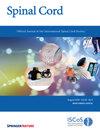Challenges and strategies for spinal cord injury research recruitment in rehabilitation hospitals: a single center perspective
IF 2.2
4区 医学
Q3 CLINICAL NEUROLOGY
引用次数: 0
Abstract
A narrative review and perspective based on the experience of a single site in the U.S recruiting participants for clinical trials during the subacute phase (2 weeks to 3 months) following a traumatic spinal cord injury (SCI). To discuss challenges and propose strategies for enrolling individuals with SCI in research during the subacute phase within a comprehensive inpatient rehabilitation program. Acute rehabilitation hospitals where patients with SCI typically spend part of the subacute post-injury period. This review draws on the authors’ experience in research recruitment and retention. Key barriers and potential solutions are explored from both a practical and conceptual standpoint. Challenges identified include heterogeneous impairments, older age, higher incidence of incomplete injuries, placement issues, competition among studies, limited patient volume, tight rehabilitation schedules, logistical and medical concerns, and misalignment of research measures with clinical practices. Based on experience and literature review, strategic planning including integration of individuals with lived experience into the study design team, patient education, simplified consent processes, flexible research protocols, collaboration between clinical and research teams, and patient-centered approaches can enhance recruitment efforts. Research recruitment during the subacute phase of SCI presents numerous medical, injury-specific, and systems-based challenges. However, this period remains critical for advancing research influencing long-term outcomes for individuals with SCI. We recommend a collaborative, patient-centered approach that integrates research within clinical care, guided by practical experience and informed by existing literature, which can improve recruitment efforts and ultimately support meaningful advancements in SCI rehabilitation research.康复医院脊髓损伤研究人员招聘的挑战与策略:单中心视角
研究设计:基于美国单一地点的经验,在创伤性脊髓损伤(SCI)后亚急性期(2周到3个月)招募临床试验参与者的叙述性回顾和观点。目的:讨论在综合住院康复计划的亚急性期纳入脊髓损伤患者研究的挑战并提出策略。环境:急性康复医院,脊髓损伤患者通常度过亚急性损伤后期的一部分。方法:回顾作者在科研人员招聘和留用方面的经验。从实践和概念的角度探讨了主要障碍和潜在解决方案。结果:确定的挑战包括异质性损伤、年龄较大、不完全性损伤发生率较高、安置问题、研究之间的竞争、有限的患者数量、紧张的康复时间表、后勤和医疗问题以及研究措施与临床实践的不一致。基于经验和文献回顾,战略规划包括将有生活经验的个体纳入研究设计团队、患者教育、简化同意流程、灵活的研究方案、临床和研究团队之间的合作以及以患者为中心的方法可以加强招募工作。结论:脊髓损伤亚急性期的研究招募面临着许多医学、损伤特异性和基于系统的挑战。然而,这一时期对于推进影响SCI患者长期预后的研究仍然至关重要。我们推荐一种协作的、以患者为中心的方法,将研究与临床护理结合起来,以实践经验为指导,并参考现有文献,这可以改善招募工作,最终支持脊髓损伤康复研究的有意义的进展。
本文章由计算机程序翻译,如有差异,请以英文原文为准。
求助全文
约1分钟内获得全文
求助全文
来源期刊

Spinal cord
医学-临床神经学
CiteScore
4.50
自引率
9.10%
发文量
142
审稿时长
2 months
期刊介绍:
Spinal Cord is a specialised, international journal that has been publishing spinal cord related manuscripts since 1963. It appears monthly, online and in print, and accepts contributions on spinal cord anatomy, physiology, management of injury and disease, and the quality of life and life circumstances of people with a spinal cord injury. Spinal Cord is multi-disciplinary and publishes contributions across the entire spectrum of research ranging from basic science to applied clinical research. It focuses on high quality original research, systematic reviews and narrative reviews.
Spinal Cord''s sister journal Spinal Cord Series and Cases: Clinical Management in Spinal Cord Disorders publishes high quality case reports, small case series, pilot and retrospective studies perspectives, Pulse survey articles, Point-couterpoint articles, correspondences and book reviews. It specialises in material that addresses all aspects of life for persons with spinal cord injuries or disorders. For more information, please see the aims and scope of Spinal Cord Series and Cases.
 求助内容:
求助内容: 应助结果提醒方式:
应助结果提醒方式:


